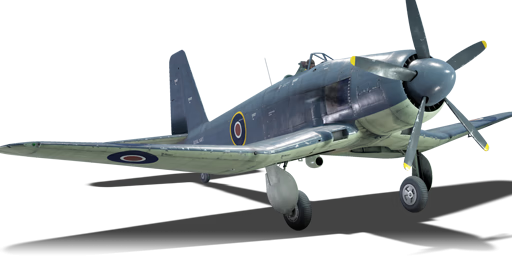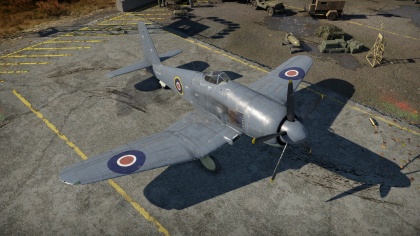Firecrest
Contents
Description
The Firecrest is a squadron rank II British fighter
with a battle rating of 2.7 (AB), 2.3 (RB), and 3.3 (SB). It was introduced during Update 1.89 "Imperial Navy" as one of the first Squadron vehicles. It represents the attempt to develop an improved naval aircraft from the troubled , Blackburn Firebrand.
In reality only 3 prototypes were ever made since the arrival of improved technologies such as the Jet engine, halted any major development of war birds with piston engines after the Second World War.
However in the game, everyone's got a chance with the Firecrest. It could be considered as a hybrid between the Firebrand and a Corsair F4U. Due to its gull shaped wings, durability, powerful engine and beautiful sleek appearance! Howbeit, it got other traits that make this plane well suited for the naval environment of War thunder.
General info
Flight performance
Once upgraded and spaded, the Firecrest is able to go anywhere it must go. Climbing to the sky or speeding steadily to a target. It all can be achieved.
The Bristol Centaurus-18 engine holding a 2,475 HP is able to accelerate pretty quickly. Something greatly needed for sea and carrier operations. This allows the plane to climb steadily to 6 km of altitude where the max speed can also be achieved. Conserving all of the maneuverability due to the supercharger and a great roll rate.
If necessary it can dive very fast and possesses air brakes for handling such speeds with ease. It does not turn that good horizontally but the skilled control of combat flaps and the airbrakes can prove adequate in several instances.
It's recommendable to engage planes without the carry of ordinance to maximize your flight performance. Notably the torpedo load.
| Characteristics | Max Speed (km/h at 5,791 m) |
Max altitude (metres) |
Turn time (seconds) |
Rate of climb (metres/second) |
Take-off run (metres) | |||
|---|---|---|---|---|---|---|---|---|
| AB | RB | AB | RB | AB | RB | |||
| Stock | 587 | 568 | 10975 | 24.1 | 25.0 | 15.4 | 15.4 | 300 |
| Upgraded | 636 | 608 | 21.9 | 23.0 | 23.6 | 19.0 | ||
Details
| Features | ||||
|---|---|---|---|---|
| Combat flaps | Take-off flaps | Landing flaps | Air brakes | Arrestor gear |
| ✓ | ✓ | ✓ | ✓ | ✓ |
| Limits | ||||||
|---|---|---|---|---|---|---|
| Wings (km/h) | Gear (km/h) | Flaps (km/h) | Max Static G | |||
| Combat | Take-off | Landing | + | - | ||
| 0 | 360 | 430 | 430 | 272 | ~10 | ~4 |
| Optimal velocities (km/h) | |||
|---|---|---|---|
| Ailerons | Rudder | Elevators | Radiator |
| < 460 | < 450 | < 450 | > 330 |
| Compressor (RB/SB) | ||
|---|---|---|
| Setting 1 | ||
| Optimal altitude | 100% Engine power | WEP Engine power |
| 1,280 m | 2,580 hp | 2,895 hp |
| Setting 2 | ||
| Optimal altitude | 100% Engine power | WEP Engine power |
| 4,980 m | 2,310 hp | 2,587 hp |
Survivability and armour
- None.
The pilots should notice that no armor protection is present, this will limit your ability to tolerate heavy fire since any armor piercing bullet is capable of going through your entire plane. The strongest and yet the more vulnerable part of the plane is the engine. No head-on engagements or attacking bombers are advised since the radial engine with the pilot can be easily taken out.
Separately, the fuselage is quiet resilient and sleek curvy. This can often ricochet fire that would otherwise enter the spar and inflict greater damage. The only thing protecting the pilot from behind aside the fuselage, is a fuel tank.
Armaments
Offensive armament
The Firecrest is armed with:
- 2 x 12.7 mm M3 Browning machine guns, wing-mounted (300 rpg = 600 total)
Suspended armament
The Firecrest can be outfitted with the following ordnance:
- Without load
- 2 x 500 lb G.P. Mk.IV bombs (1,000 lb total)
- 1 x 450 mm (18 inch) Mark XV torpedo
- 8 x RP-3 rockets
Usage in battles
The Firecrest is an experimental torpedo bomber with average capacities. It has low anti-air effectiveness in air Arcade battles due to rather clumsy maneuvering and no armor protection. A good pilot is needed to fully exploit the handy machine guns this plane owns. It has a place in tank Realistic Battles, thanks to its payload capacities and the extremely powerful 8x RP-3 rockets. However its best place in Naval Battles, where you can engage more freely in wider spaces and make use of your full ordnance capacities (once the Mark XV torpedo is unlocked for use). Due to the lackluster firepower when stock , one of the recommended ways to gain the necessary research points for unlocking modules is to simply attack AI targets like artillery and trucks, then tanks as the 500 lb bombs are unlocked prior to the torpedoes.
Naval Battles
Once the torpedoes are unlocked, the Firecrest performs similarly to other torpedo bombers of the rank. One of the outstanding traits is in its high survivability that can help in destroying one target if the tactics are played to the plane's strength (Good roll perfect for low altitude fly). Aim towards destroyer or cruiser as they are larger targets that are easier to hit and prioritize the vessels that are threatening allies on the seas. However, try to ensure the enemy ship is occupied with attacking surface targets so that their anti-air armament is not focused on the Firecrest to allow for some breathing room to position for an attack run.
Encounter mode proves to be one of the best for this plane. Here will be possible to infiltrate by the sides at low level flight behind the enemies to the cargo ships, and release a torpedo from a safe distance. Always keeping in mind the torpedo drop requirements and the target. You can risk a bit more if you equip bombs, but a tactic that might also work its to skip the bombs to the cargo ship swiftly retreating in the same direction, in a tactic that is known as Skip bombing.
Manual Engine Control
| MEC elements | ||||||
|---|---|---|---|---|---|---|
| Mixer | Pitch | Radiator | Supercharger | Turbocharger | ||
| Oil | Water | Type | ||||
| Not controllable | Not controllable | Controllable Auto control available |
Controllable Auto control available |
Separate | Controllable 2 gears |
Not controllable |
Modules
| Tier | Flight performance | Survivability | Weaponry | ||
|---|---|---|---|---|---|
| I | Fuselage repair | Radiator | HMBC mk.2 | ||
| II | Compressor | Airframe | Offensive 12 mm | FTC mk.IV | |
| III | Wings repair | Engine | HRC mk.8 | ||
| IV | Engine injection | Cover | New 12 mm MGs | ||
Pros and cons
Pros:
- High rate of fire of M3 Browning provides rapid damage output
- Good top speed overall with decent acceleration
- Respectably durable
- Has RP-3s and bombs against ground targets
- Good all altitude performance
- Excellent high speed control
- Has airbrakes
- Interceptor spawn
Cons:
- Not very manoeuvrable, especially at low speeds
- Only 300 rounds per machine gun; trigger discipline is needed
- Only 2 machine guns which means very limited firepower
- Limited payload options compared to Firebrand and contemporary naval planes of the FAA
- Large engine is vulnerable to incoming fire
- No armor, not recommended to engage bombers
History
The Blackburn Firecrest was a British Torpedo Strike Fighter, derived from the earlier Blackburn Firebrand but designed from the outset as a torpedo strike fighter. Designed to the S.28/43 specification set by the Admiralty on February 26th 1943 for a 'Firebrand Torpedo Fighter with improved wing and improved pilot view', the Firecrest was designed with a number of issues of the Firebrand in mind. Specifically, effort was done to produce a type which had improved forward visibility to facilitate deck landings, and which had better lateral control at landing speeds. The design specification also called for the Firecrest to be powered by a Bristol Centaurus 77 engine powering a contra-rotating propeller.
Early on during its design, the Admiralty also ordered three prototypes which would have been driven by the Napier E.122 24-cylinder H-block engine, a 3500 hp development of the Napier Sabre used on the original Firebrand. However, it was soon found that in order to maintain an acceptable center of gravity, the heavy Napier engine would have to be installed behind the cockpit, which would require an extensive redesign and add considerable weight to the aircraft. As a result, the Napier E.122 powered variant was cancelled in October of 1945 before metal was cut on any of their prototypes. Just before completion of the design, the Centaurus 77 variant with its contra-rotating propeller was cancelled in January of 1946, and it was replaced by a 2,825 hp Centaurus 57 with a conventional five-bladed propeller. The first of three completed prototypes of the Firecrest flew on April 1st 1947.
The Firecrest differed from the Firebrand in having a cockpit that was set higher and more forward than that of the Firebrand, which combined with a shortened nose did improve the forward visibility during deck landing. A redesigned inverted gull wing conceptually not unlike that of the Vought Corsair did much to improve the type's low speed handling and take off characteristics: even at full weight, take-off was possible in just under 430 ft with a 29 mph headwind; it's landing run was an impressive 390 ft with a 5 mph headwind. With its conventional five-bladed propeller, the Firecrest's top speed lay at 380 mph, some 38 mph faster than the Firebrand despite weighing slightly more. Unlike the Firebrand which used hand-folded wings, the Firecrest had power-assisted folding wings with a double fold.
However, it soon became apparent that the Firecrest was even more sluggish in handling than the Firebrand, that the design in itself did not give any distinct advantages over the Firebrand or the newly developed Westland Wyvern, and that it was less versatile than types such as the Fairey Firefly or Hawker Sea Fury. As a result, all development work on the Firecrest ceased in September of 1947, with the second prototype only being used for structural testing, and the third prototype used to test the power-boosted ailerons which were eventually fitted to the Firebrand TF.5A. All three prototypes were bought back by Blackburn in 1950, and scrapped in 1952.
Media
- Videos
See also
Links to the articles on the War Thunder Wiki that you think will be useful for the reader, for example:
- reference to the series of the aircraft;
- links to approximate analogues of other nations and research trees.
External links
Paste links to sources and external resources, such as:
- topic on the official game forum;
- encyclopedia page on the aircraft;
- other literature.
| Blackburn Aircraft Ltd. | |
|---|---|
| Fighters | Firebrand TF Mk IV · Firecrest |
| Strike aircraft | Buccaneer S.1 · Buccaneer S.2 · Buccaneer S.2B |
| Britain squadron aircraft | |
|---|---|





